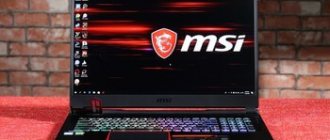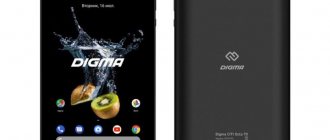17? 24? 27? Which diagonal should I choose? With or without backlight? What should the screen resolution be? What are the types of matrices? Choosing a modern gaming monitor can be a real headache, because the number of different characteristics is off the charts, and the service life is not one or two years. Together with our partners from MSI, we will tell you how to choose a gaming monitor and what parameters are the main ones in this matter.
Diagonal and screen resolution
At first glance, it seems that the choice is limited by budget and the amount of free space on the table. However, it is worth remembering that the higher the resolution, the greater the load on the video card. One chip will produce a different number of frames per second at Full HD and at QHD. The most popular resolution is 1920x1080 - this is the minimum for modern gaming. Less makes sense only in laptops with a small diagonal. As for sizes, there are many of them: from small 23-inch models to giants like the Samsung C49HG90DMI, which can easily replace two screens.
The best option is a diagonal of 27-32 inches with an aspect ratio of 16:9. Most games are developed based on this format: they will take up the entire screen, without leaving black bars around the edges, and there will be no need for image scaling. If you're going to be playing in 4K, a large 31-40 inch TV-like monitor will work well. However, note that Windows still doesn't adapt well to high resolutions (icons and text become too small), and some games not designed for 4K are severely distorted. The zoom functions do not always help.
Please note that there is no point in high resolution if the diagonal is small. In this case, you will not see all the benefits of high detail. This rule also works in the opposite direction. There is no point in buying a monitor with a large diagonal and low resolution. For example, Full HD doesn’t look the best on a 27-inch screen: many users complain about high graininess, due to the fact that every pixel can be seen with the naked eye.
There is also a format of curved monitors: they differ from flat ones in their smaller viewing angle and body shape. Such a device is worth buying only for gaming - playing behind a curved display while sitting directly in front of it is quite comfortable, due to the fact that the extreme points of the screen are closer to the eye than in the case of a flat monitor. But watching movies, especially in a group, will be inconvenient: half of the picture is not visible from the side of such a screen.
What are the standard sizes of monitors on the market?
22" monitor
Nowadays, 22-inch monitors often have resolutions ranging from 1366x768 to 1920x1080 (Full HD/1080p). They've largely been replaced by the rise of 24-inch monitors, but you'll still see a few of them in the wild from time to time.
24" monitor
24-inch monitors are standard and are most often found at 1080p resolution. You may also see some 1440p and even 4K 24-inch monitors, but they are not generally considered ideal for this resolution. We'll dive into this later.
27" monitor
These days, 27-inch monitors typically have a resolution of 1440p, although 1080p or 4K are sometimes found. However, we strongly recommend not buying a 27-inch 1080p monitor as you will start to notice pixelation.
32" monitor
At this point, some of you may be thinking, "Wait, isn't that a TV?" Although 32-inch monitors are less common, they are already making their way onto store shelves and can usually be found in resolutions ranging from 1080p to 4K.
More, less and everything in between
There are smaller monitors, larger monitors, and something in between. But there is nothing magical about intermediate sizes: they are simply outside the norm. However, I recommend sticking to the 24 to 27 inch range . Anything less and you'll lose too much. More than that, this already creates problems with using the desktop.
Brightness, contrast and matrix coverage
Choose a model with a brightness of at least 250 cd/m2. During the game you will be close to the monitor and, if necessary, you can reduce it. However, in a room with bright or natural light, high brightness will keep the image on the screen clearly readable. The contrast must be at least 1000:1, otherwise the image will not look sharp enough. We also advise you to pay special attention to the presence of modes to protect your eyesight: they will come in handy during a long game.
The screen coating can be glossy or matte. It is believed that gloss makes the picture “juicier”, but it does reflect a lot. The matte coating will not reflect, but will not embellish the picture. If you play in the evenings and there are no bright light sources or glare in your room, feel free to choose a glossy monitor. If there is always something shining into your screen, it is better to choose a panel with a matte finish.
Gaming monitor matrix type
By and large there are three options: TN, VA and IPS. TN matrices are characterized by low response time and low price: budget models mostly contain TN panels. However, this type has lower contrast (compared to IPS) and smaller viewing angles. VA is an average matrix in terms of characteristics, which is between TN and IPS. In terms of price, it is also in the middle segment. IPS monitors are a little more expensive and not as fast as TN ones. But they have better color rendition and wider viewing angles. For an IPS panel with a response time of 1 ms you will have to pay at least 3,000 more than for a similar model with a TN matrix.
If you play online games and the frame rate counter comes first for you, and the picture quality does not matter at all, feel free to take TN. If you prefer mostly single projects with rich graphics, then take a closer look at VA or IPS.
No. 10 – BenQ GW2283 21.5″
Price: 7,700 rubles
One of the cheapest models in our rating. It will be the best option for users with a limited budget. In addition to the IPS matrix, the solution can boast of a light sensor. Thanks to it, the monitor will automatically adjust the brightness. Judging by customer reviews, he does this quite adequately.
The monitor's interface is designed competently, switching between items is convenient, and there are various customization options. Note the blue tint suppression feature, which will prevent your eyes from hurting even after long gaming sessions. The disadvantages are the lack of an HDMI cable in the kit and the built-in speakers are completely useless.
BenQ GW2283
Frame Rate (Hz)
The frame rate is measured in Hertz and represents the number of frames a monitor can display in one second. The minimum for gaming is 60 Hz, but this value is only suitable for single games. In online battles, where there are many dynamic scenes, the smoothness of the picture is much more important. Therefore, it is better to choose 120, 144 or even 240 Hz displays.
At the moment, 240 Hz is the highest frequency that can be found on the market. Devices with this indicator are much more expensive than their slower counterparts. The cheapest 240 Hz monitor costs 20,000 rubles - this is the Acer KG251QDbmiipx with a diagonal of 27 inches and Full HD resolution. Monitors with 144 Hz are especially popular: the choice in this segment is much greater than among models with support for 240 Hz, you can even find devices with a diagonal of up to 49 inches.
No. 7 – LG 25UM58 25″
Price: 13,000 rubles
Popular model in Russia. The love of users is due to the excellent price-quality ratio. This is a widescreen monitor with a resolution of 2560 by 1080 pixels. Thanks to this, you will have an increased view of modern games, as well as more work space. The latter is beneficial for those who often work in several windows at the same time. The connection is made via HDMI; a corresponding cable is supplied.
The color rendition of the monitor is quite rich and rich, the backlight is uniform, without glare. As for the minuses, the actual response time is about 20 ms, the lack of adjustments, as well as the poor placement of the connectors, like the previous competitor.
LG 25UM58
G-Sync/FreeSync support
Video card manufacturers have developed adaptive synchronization technologies, with the support of which the monitor provides the smoothest picture possible. NVIDIA has G-Sync, and AMD has FreeSync. Models with G-Sync are more expensive, but they work with popular gaming video cards from NVIDIA.
On paper, the benefits of adaptive synchronization are obvious, but gamers are still arguing whether it makes sense in practice. We recommend choosing a monitor that supports G-Sync/FreeSync to eliminate image tearing and other visual defects using these technologies. In addition, hardware and video card drivers are regularly updated, which means frame synchronization technologies will also improve.
Connection
Modern video cards use HDMI, DVI, DisplayPort and Mini DisplayPort connectors. VGA is already rare. To transmit 4K 30 fps, you will need support for HDMI 1.4, for 4K 60 fps - HDMI 2a or Displayport 1.3/1.4.
- Technologies
What is HDMI? Comparing cable types
Also, many gaming monitors are equipped with built-in speakers, a headphone jack, USB-A and USB-C ports, which allow you to connect peripherals or charge your smartphone. Additional functionality should be selected as needed. However, we note that the built-in speakers in the vast majority of cases will not have the best sound.
Overall: what a good gaming monitor should be like
A properly selected gaming monitor will have the following characteristics: a diagonal of at least 27 inches with an aspect ratio of 16:9, a response time of 1-5 ms, a frame refresh rate of 60 Hz, support for G-Sync/FreeSync and the presence of HDMI and DisplayPort interfaces for connecting modern video cards All other parameters (for example, the appearance of the device and additional connectors) depend on your taste and budget. So that you don’t have to choose for a long time, we have compiled a small top monitors.
No. 2 – ASUS ROG Swift PG279Q 27″
Price: 62,000 rubles
One of the latest innovations from ASUS. Experts agree that it is perfect for any gamer. Fans of single-player games will appreciate the gorgeous color rendering, which allows them to admire beautiful views, and fans of dynamic shooters will appreciate the maximum refresh rate of 165 Hz. In addition, the monitor can be adjusted in height. The model’s menu is very rich - there are many modes, it’s convenient to switch between them using the joystick.
The reliable monitor stand is backlit, which looks very impressive in the dark. The matrix out of the box has excellent calibration. She has no problems with glare, dead pixels and loops. The only disadvantage of the new model is the cost.
ASUS ROG Swift PG279Q
The best gaming monitors of 2021: model ratings
Iiyama G-Master G2730HSU-1
The gaming monitor from Iiyama meets all our requirements: it is a 27-inch diagonal TN panel, decent resolution (1920x1080 pixels), FreeSync support and a low response time of 1 ms. HDMI, DisplayPort and even VGA connectors are used to connect to a computer. Plus, there are speakers and a USB hub. Moreover, the model costs only 13,000 rubles.
HP OMEN 27
An almost frameless gaming monitor from HP based on a TN matrix with a 2K resolution is suitable for shooters and racing. The 165Hz frequency, 1ms response time and G-Sync support promise smooth images even in fast-paced gaming scenes.
AOC G2590FX
If you are looking for a small gaming monitor, pay attention to the model from the popular manufacturer AOC. The 24.5-inch matrix looks very unusual: it has almost no frames. The resolution matches the screen size - Full HD. Other characteristics are at the level of top models: 1 ms, 144 Hz, FreeSync support.
MSI Optix AG32CQ
The curved monitor with a diagonal of 31.5 inches is distinguished by an unusual type of matrix for a gaming device - VA, which provides a response time of 1 ms and good color rendition. There's also FreeSync support and a high refresh rate of 144Hz.
Xiaomi Redmi Display 1A
As a budget solution for an inexperienced gamer, products from the affordable Xiaomi brand are suitable. It cannot be said that this model stands out from the rest in any way (except perhaps for its low price), but it is equipped with the most minimal set of necessary characteristics. Polling rate - 60 Hz, brightness - 250 cd/m², matrix - IPS.
Xiaomi Mi Surface Display
But you shouldn’t associate the Chinese corporation only with budget devices. Here is a model for 34,000 rubles, which has excellent characteristics and offers gamers 4K resolution, a high contrast ratio of 3000:1 and a refresh rate of 144 Hz. Almost all reviews of the model are extremely positive.
No. 9 – Acer Nitro VG240Ybmipcx 23.8″
Price: 12,000 rubles
Our ranking of gaming monitors moves further. The VG240Y is another relatively inexpensive model. Its special feature is the refresh rate of 75 Hz. Of course, this is not 144 Hz in terms of smoothness, but it is still better than the usual 60 Hz and playing shooters on such a monitor is much more comfortable, as confirmed by reviews from owners. Let's note a rich set of connectors - there is HDMI, VGA, DisplayPort, so you won't have any problems connecting the monitor to the video card.
An interesting feature of the budget model is the presence of a built-in webcam. The monitor looks stylish, has thin frames, so it will fit organically into a gamer’s corner. The leg ensures reliable stability of the device on the table and takes up minimal space. The disadvantages of Eiser's creation include the lack of height and tilt adjustment options.
Acer Nitro VG240Ybmipcx










